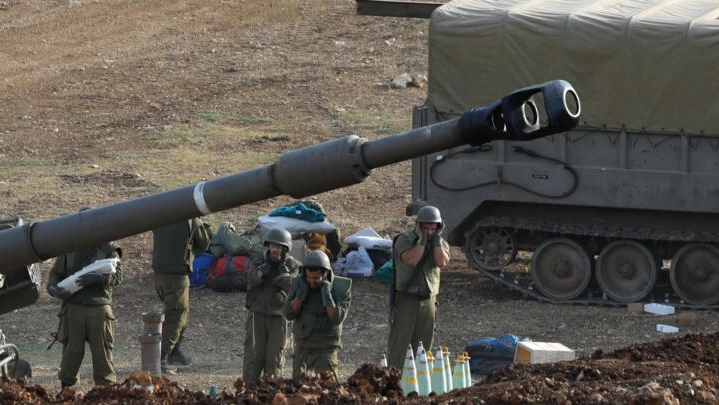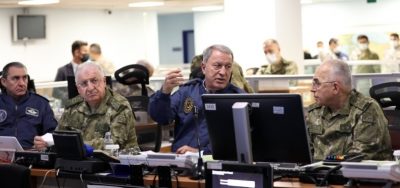While Israel has amassed tanks and troops around the Gaza border to the south, rocket fire and shelling incidents on its northern borders with Lebanon and Syria have multiplied since the October 7 Hamas attack on Israel. Amid fears of a renewed uprising in the West Bank, security experts are questioning Israel’s ability to respond to simultaneous, multi-pronged attacks and threats on different fronts. (Issued on
As Israel ordered an unprecedented evacuation of northern Gaza ahead of an expected ground offensive, Hezbollah on Friday said it was “fully prepared” to join its ally Hamas in the war against Israel “when the time comes for action”.
The declaration by Hezbollah deputy chief Naim Qassem came as an Israeli shell on Friday landed in a gathering of international journalists across its northern border in Lebanon, killing one journalist and wounding six others. The latest shelling came after days of limited tit-for-tat exchanges between Israel and Hezbollah following the October 7 Hamas attack on Israel.
As Qassim was addressing a rally in the southern suburbs of Beirut, Iranian Foreign Minister Hossein Amir-Abdollahian was in Lebanon meeting Hezbollah chief Hassan Nasrallah.
Iran, which financially and militarily backs Hezbollah and Hamas, has been calling on allies and regional Arab nations to form a united front against Israel over the past few days.
With Palestinian groups in the occupied West Bank calling for an uprising against Israel, clashes erupted on Friday in several cities – including Ramallah, Nablus, Tulkarem and Hebron – resulting in at least nine Palestinians killed by Israeli fire, according to the Palestinian health ministry.
On Thursday, Iranian Foreign Minister Amir-Abdollahian warned Israel that “new fronts” might be opened against the country unless it stops bombing Gaza.
It’s a warning that security analysts have been considering since October 7, when an Israeli ground invasion of Gaza appeared imminent.
“There is a clear risk that Tel Aviv will find itself having to manage several fronts at the same time,” said Veronika Poniscjakova, an Israel-Middle East security expert at the University of Portsmouth.
To the north, the Hezbollah threat
In the north, the most pressing threat to Israel is on the border with Lebanon, where Hezbollah attacks have grown in intensity in recent days. This includes a guided missile strike into Israeli territory on Wednesday, according to Hezbollah.
Meanwhile, at least six Islamic Jihad militants “attempted to cross into Israeli territory from southern Lebanon from October 8-9,” according to the Washington DC-based Institute for the Study of War.
In the Golan Heights, the situation is more confused. Rockets have been fired into the Golan Heights, but “at this stage, we don’t know who fired them,” said Poniscjakova. “The most likely suspect remains Hezbollah, which has a proven presence in Syria,” she added.
But Hezbollah is not the only suspect. “It could also be one of the many small pro-Palestinian groups operating from Syria, such as the Popular Front for the Liberation of Palestine-General Command [PFLP-GC],” explained Clive Jones, an expert on Israel and the Middle East at Durham University.
In addition, pro-Syrian regime forces have also been deployed to the border between Syria and Israel since October 9, according to the Institute for the Study of War (ISW). The Syrian Social Nationalist Party’s militant wing, the Eagles of the Whirlwind, “deployed forces and promised support on October 9,” said the ISW briefing.
The Israeli army’s fear is that this explosive situation to the north will degenerate even further if and when Israel launches a ground offensive on Gaza. This in turn would put enormous pressure on the Israeli defence forces.
“It is estimated that Hezbollah alone can mobilise between 80,000 and over 100,000 rockets, some of which are long-range guided missiles,” explained Jones.
Would Israel then be able to withstand the shock of a war on several fronts?
“In theory, it’s entirely possible, as the Israeli army has been trained for an attack from several countries at once,” said Sim Tack, a military analyst who worked on armed conflicts involving Israel in Lebanon and Gaza in 2012 and 2014 for Force Analysis, a conflict monitoring company. In 1973, for example, the Israeli army successfully repelled attacks from Egypt and Syria during the Yom Kippur War.
But in practice, such a scenario “would stretch defences and could very quickly prove very costly”, said Jones. To cope with such a war, “Israel would probably have to draw on all its reserves, which would have an obvious impact on the economy if it’s a long conflict,” he added. This is one of the reasons Israel does everything in its power to conduct quick military campaigns, Jones noted.
Pressure on the ‘Iron Dome’
The real test ultimately “depends on what the Israeli army wants to achieve,” said Tack. Israel will have less trouble if it can deal with the threat in the north solely by carrying out air strikes on Hezbollah positions and intercepting missiles fired by the Shiite militia and its allies. “But if we have to physically destroy enemy positions, it will be much more difficult to manage both the southern and northern fronts,” he explained.
Another problem for Israel would be whether its air defences – its famed “Iron Dome” – would remain effective if there were multi-pronged rocket attacks launched from Gaza as well as the border with Lebanon and Syria at the same time.
Israel has just 10 Iron Dome batteries, each of which can defend an area of around 150 square kilometers against rocket fire. With a total area of nearly 22,000 square kilometers, it would be impossible to protect the entire country. “It is possible that Israel will be forced to make a choice,” said Tack.
The Iron Dome is a system designed against short-range shells, which are Hamas’s main weapon in the Gaza Strip. But Hezbollah has a more sophisticated arsenal, and if a war breaks out on several fronts, “one of the Israeli army’s first objectives will have to be to destroy the pro-Iranian movement’s long-range missile launchers,” explained Jones.
And that’s not counting possible attacks from the West Bank. While Hamas has a presence in the West Bank, “it will be difficult for it to launch large-scale military operations, not least because of power struggles with Fatah – which governs this territory,” said Poniscjakova, referring to the secular nationalist faction led by Palestinian President Mahmoud Abbas, which has long been a Hamas rival.
In addition to Fatah, there are “a whole series of small groups of young militants who have formed in recent years, with no allegiance to either Fatah or Hamas, and who can pose a serious problem for Israel,” said Jones.
The US deterrence turns target
The new, smaller Palestinian militant groups that have emerged over past few years in response to the Israeli occupation are not equipped to fire shells into Israel or carry out incursions. But, “if they were to attack Israeli settlements, other young people might join in, which could turn into a popular uprising. The Israeli army doesn’t need the added burden of securing these settlements right now,” noted Jones.
Israel’s main insurance policy against a multi-front war is the US. Washington’s military messaging so far has been consistent. Arriving in Tel Aviv on Friday, US Defense Secretary Lloyd Auston told Israeli leaders “we have your back”.
The US aircraft carrier, the USS Gerald Ford, arrived in the eastern Mediterranean on Wednesday, and a second carrier is making its way to the region from Virginia.
“The arrival of the aircraft carrier USS Gerald Ford off the coast of Israel should serve to discourage Hezbollah and other groups from striking Israel,” noted Poniscjakova.
But for the deterrent to work, “Washington must really be prepared to strike Hezbollah positions” she added.
In other words, is the US prepared to fire on Lebanese or Syrian territory? As far as Syria is concerned, all the experts interviewed by FRANCE 24 believe this a last-resort option, as it could be perceived as a provocation by Russia, Syrian President Bashar al-Assad’s main ally. On the other hand, “the United States could react if Hezbollah started striking densely populated areas in Israel,” said Jones.
Any US intervention would lead to an escalation of tensions in the region. Several pro-Iranian groups, such as the Houthis in Yemen or the Badr organisation in Iraq, have already warned that they would be ready to intervene if Washington got involved in the conflict.
“They would find it difficult to strike Israel directly,” said Jones. “But they could attack American interests in the region.”
(This is a translation of the original in French.)
Source: France 24




